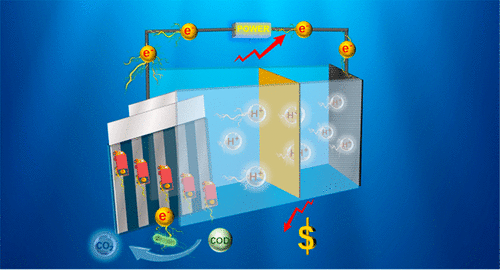当前位置:
X-MOL 学术
›
ACS ES&T Eng.
›
论文详情
Our official English website, www.x-mol.net, welcomes your
feedback! (Note: you will need to create a separate account there.)
Enhanced Microbial Electrochemical Systems Performance by Optimizing the “Anode-Collector” Collection Mode: From Enhancement Mechanism to Construction Strategy
ACS ES&T Engineering ( IF 7.4 ) Pub Date : 2022-01-08 , DOI: 10.1021/acsestengg.1c00396 Jiannan Li 1 , Guohong Liu 1 , Dahong Chen 1 , Chao Li 1 , Dandan Liang 1 , Fei Wang 1 , Jing Wu 1 , Weihua He 1 , Yanling Yu 1, 2 , Yujie Feng 1
ACS ES&T Engineering ( IF 7.4 ) Pub Date : 2022-01-08 , DOI: 10.1021/acsestengg.1c00396 Jiannan Li 1 , Guohong Liu 1 , Dahong Chen 1 , Chao Li 1 , Dandan Liang 1 , Fei Wang 1 , Jing Wu 1 , Weihua He 1 , Yanling Yu 1, 2 , Yujie Feng 1
Affiliation

|
The microbial electrochemical system (MES) provides a new idea for the recovery and utilization of energy contained in wastewater. Still, the inherent resistance of the commonly used carbon-based anode material of the system often leads to power loss during the electron collection process and reduces the system performance, especially in scale-up operations. Through experimental verification, we found that integrating a metal current collector into the anode and increasing its branches was an effective strategy to reduce power loss and enhance the system performance in the case of a limited area of a current collector. The system with five branches could obtain a higher maximum power density (1613.3 ± 155.5 mW/m2), 1.36 times that of system with one collector branch (1185.1 ± 29.1 mW/m2), and the corresponding power loss reduced by 86.7%. COMSOL software was used in MES to reveal the enhancement mechanism and provided effective “anode-collector” construction strategies. The simulation results indicated that at least three current collector branches should be integrated into the anode in scale-up MES to avoid excessive power loss. When using an optimized “anode-collector” combination to treat domestic wastewater, the system could quickly capture energy in sewage (≈20 h), and the effluent met the grade A standard of COD for municipal wastewater treatment plants in China (<50 mg/L). Moreover, this strategy only needed approximately $0.061 of cost per milliwatt of electricity generated, lower than the commonly used carbon brush anode ($0.08/mW). These results demonstrate that optimizing the “anode-collector” collection mode can effectively enhance energy harvesting and system performance with low cost and has promising potential for future practical applications.
更新日期:2022-02-11











































 京公网安备 11010802027423号
京公网安备 11010802027423号